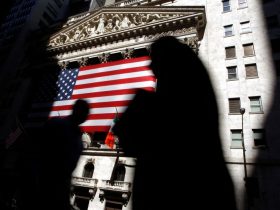Middle-class Americans are increasingly anxious about the economy, despite a strong job market and a blowout GDP report showing an unexpected Q3 growth surge of 4.9%, according to a Harris Poll for Bloomberg News. The Federal Reserve’s aggressive interest rate campaign, aimed at curbing inflation that hit a 40-year high in 2022, is causing this unease. The poll reveals that 57% of middle-class Americans feel these higher interest rates are negatively impacting their household finances and 44% are stressed about the economy.
The Federal Reserve has adopted a “higher-for-longer” policy, maintaining interest rates at peak levels of 5.25%-5.5% in September, with indications of another increase this year. Investors using CME Group’s (NASDAQ:) FedWatch tool anticipate steady rates at the November meeting but some predict a December rate hike. These higher interest rates have pushed up the federal funds rate and 30-year mortgage rates, affecting borrowing costs for home equity lines of credit, auto loans, and credit cards.
The survey by the Harris Poll also indicates escalating economic anxiety due to these higher borrowing costs exacerbating economic stress. As a result of the Fed’s anti-inflationary measures, US consumers paid a record $130 billion in credit card interest and fees last year, as reported by the Consumer Financial Protection Bureau. If the 4.9% annual growth rate recorded in Q3 continues to fuel inflation, further rate hikes may ensue.
Middle-class individuals like Rebecca Acuna from Indianapolis, Tiffany Bond from Maine, and Tom Maley from Ohio have voiced concerns about managing finances and affordability issues amidst these conditions. This apprehension poses a challenge to President Joe Biden’s “Bidenomics” agenda aimed at empowering the middle class. The situation is further complicated by record car payment defaults and generational differences in economic outlooks.
Karl Jacob, CEO of LoanSnap, warns that this era of higher interest rates will burden Americans and potentially impact the broader economy. Meanwhile, inflation, as measured by the Consumer Price Index reported by the Labor Department, remains above the Fed’s 2% target.
This article was generated with the support of AI and reviewed by an editor. For more information see our T&C.
Read the full article here









Leave a Reply